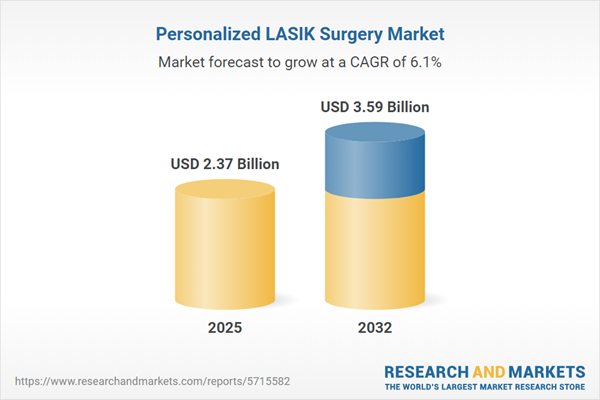Speak directly to the analyst to clarify any post sales queries you may have.
As the demand for advanced, tailored refractive solutions grows, the personalized LASIK surgery market is undergoing significant transformation. Senior leaders seeking sustained competitive advantage must understand the evolving landscape shaped by patient-centric innovations, technology integration, and regulatory shifts.
Market Snapshot: Personalized LASIK Surgery Market Size and Growth
The personalized LASIK surgery market grew from USD 2.23 billion in 2024 to USD 2.37 billion in 2025 and is projected to register a compound annual growth rate (CAGR) of 6.13%, anticipated to reach USD 3.59 billion by 2032. This momentum signals robust investor confidence in next-generation vision correction and sustained demand for innovative ophthalmic procedures.
Scope & Segmentation
This comprehensive report equips decision-makers with actionable intelligence across all facets of the sector, emphasizing market-defining trends and the latest advancements.
- Technology Type: Excimer lasers, femtosecond lasers.
- Procedure Type: Smile, standard LASIK, topography-guided, and wavefront-guided procedures.
- Application: Astigmatism correction, hyperopia correction, myopia correction (including high, moderate, and low myopia).
- End User: Ambulatory surgical centers, clinics, hospitals.
- Patient Age Group: 18 to 30 years, 31 to 45 years, above 45 years.
- Regions and Key Countries: Americas (United States, Canada, Mexico, Brazil, Argentina, Chile, Colombia, Peru), Europe (United Kingdom, Germany, France, Russia, Italy, Spain, Netherlands, Sweden, Poland, Switzerland), Middle East (United Arab Emirates, Saudi Arabia, Qatar, Turkey, Israel), Africa (South Africa, Nigeria, Egypt, Kenya), Asia-Pacific (China, India, Japan, Australia, South Korea, Indonesia, Thailand, Malaysia, Singapore, Taiwan).
- Market Players: Alcon Inc., Johnson & Johnson Vision Care, Bausch + Lomb Incorporated, Carl Zeiss Meditec AG, NIDEK Co. Ltd., Topcon Corporation, Ziemer Ophthalmic Systems AG, SCHWIND eye-tech-solutions GmbH, STAAR Surgical Company, Lumenis Ltd.
Key Takeaways for Senior Decision-Makers
- Personalized LASIK leverages advanced diagnostic imaging, wavefront analysis, and adaptive optics, increasing predictability and optimizing individual outcomes.
- Shifting patient priorities toward minimally invasive procedures and rapid recovery is propelling new technology adoption, especially among tech-savvy and younger patients.
- Integration with artificial intelligence and digital patient management platforms is refining preoperative assessment, surgical planning, and post-operative engagement.
- Segmentation by age, procedure type, and technology provides diverse pathways to patient acquisition and sustained growth across demographic and regional boundaries.
- Ambulatory surgical centers and specialized clinics are shaping differentiated business models, complemented by evolving reimbursement mechanisms and premium service offerings.
- Strategic partnerships, local joint ventures, and modular equipment upgrades enable market players to remain agile while managing operational complexity and regulatory requirements.
Tariff Impact: Strategic Responses to United States Trade Policy
Recent tariffs on imported ophthalmic equipment in the United States have prompted rapid reevaluation of supply chains and cost structures. Key industry participants now emphasize regional manufacturing partnerships and local assembly initiatives to manage risk and ensure continued access to next-generation technology. Service-based contracts and bundled pricing are helping providers offset increased capital expenditures with more predictable operating expenses, ensuring resilience and protecting patient access.
Methodology & Data Sources
This report synthesizes primary interviews with refractive surgeons, equipment manufacturers, and healthcare administrators, supported by peer-reviewed literature and regulatory filings. Quantitative findings are cross-validated for accuracy, and the segmentation framework is refined through iterative stakeholder input to provide transparency and robust market tracking.
Why This Report Matters
- Informs critical investment and product strategy with granular, up-to-date insights on market dynamics and technology adoption.
- Enables executives to benchmark growth opportunities by region, patient segment, and technology type, providing clarity for resource allocation.
- Equips decision-makers to anticipate and mitigate regulatory, supply chain, and cost pressures in a rapidly evolving ophthalmic marketplace.
Conclusion
The personalized LASIK surgery market is advancing through rapid technology adoption, patient-centric care models, and evolving regulatory responses. Industry leaders who align strategy with these drivers will position their organizations for sustained growth, innovation, and measurable improvements in patient outcomes.
Additional Product Information:
- Purchase of this report includes 1 year online access with quarterly updates.
- This report can be updated on request. Please contact our Customer Experience team using the Ask a Question widget on our website.
Table of Contents
3. Executive Summary
4. Market Overview
7. Cumulative Impact of Artificial Intelligence 2025
Companies Mentioned
The companies profiled in this Personalized LASIK Surgery market report include:- Alcon Inc.
- Johnson & Johnson Vision Care, Inc.
- Bausch + Lomb Incorporated
- Carl Zeiss Meditec AG
- NIDEK Co., Ltd.
- Topcon Corporation
- Ziemer Ophthalmic Systems AG
- SCHWIND eye-tech-solutions GmbH
- STAAR Surgical Company
- Lumenis Ltd.
Table Information
| Report Attribute | Details |
|---|---|
| No. of Pages | 195 |
| Published | November 2025 |
| Forecast Period | 2025 - 2032 |
| Estimated Market Value ( USD | $ 2.37 Billion |
| Forecasted Market Value ( USD | $ 3.59 Billion |
| Compound Annual Growth Rate | 6.1% |
| Regions Covered | Global |
| No. of Companies Mentioned | 11 |









